If you want to produce new plants at home from plants you already have, then using stem cuttings is usually the most common way to do this; however, there are a number of plants that can be propagated from leaf cuttings.
Growing plants from leaves can be a fun and rewarding experience, and it allows you to expand your plant family without spending any money. In this article, we explore which indoor plants are easy to grow from leaves.
Table of Contents
- Can Plants be Propagated from Leaf Cuttings?
- Plants to Propagate from Leaves
- Snake Plant
- ZZ Plant
- Kalanchoe
- Jade Plant
- Echeveria
- Burro’s Tail (Sedum Morganianum)
- Peperomia Spp.
- Begonia
- African Violet (Saintpaulia)
- Chinese Money Plant (Pilea Peperomioides)
- Hoya
- Strawberry Begonia (Saxifraga Stolonifera)
- Cape Primrose (Streptocarpus)
- Ghost Plant (Graptopetalum Paraguayense)
- Gollum Jade (Crassula Ovata ‘Gollum’)
Can Plants be Propagated from Leaf Cuttings?
New plants can be grown in so many ways, with stem cuttings or growing from seed being among the most common routes for gardeners to take.
But did you know that one of the easiest ways to create new plants from the plants you already own is via leaf cuttings? While not all plants can be propagated in this way, there are many common house and garden plants that will produce entirely new plants from a single leaf.
Plants to Propagate from Leaves
The majority of plants that can be propagated from leaf cuttings include succulents and semi-succulents. These plants contain all of the DNA required to reproduce the entire plant in just a single leaf, making them incredibly impressive. The best plants to propagate from leaf cuttings include:
Snake Plant

- Botanical name: Dracaena trifasciata (formerly Sansevieria trifasciata)
- Common names: Snake Plant, Mother-in-Laws Tongue, St George’s Sword, Viper’s Bowstring Hemp
- Plant family: Asparagaceae
- USDA hardiness zone: 9 – 11
- Mature height: 6 feet
- Mature spread: 4 feet
The Snake Plant was botanically known as Sansevieria trifasciata up until 2017. However, this is no longer the correct name for it. The proper botanical name for the Snake Plant is Dracaena trifasciata. However, you will still find garden centers and nurseries selling these popular plants under their previous name.
These plants are native to the arid regions of Central and West Africa and are now widely grown around the world as houseplants. In their native habitats, they can reach heights of up to 6 feet, though indoors, they will rarely exceed 3 feet tall. The Snake Plant has a strong architectural look, with thick, firm, and fleshy leaves that grow vertically in clumps.
You can easily grow a new Snake Plant from a single leaf cutting to create a whole new selection of baby plants. Remove a healthy leaf from your existing plant with a sharp life, and divide this into 4-inch lengths.
It’s important to ensure each piece of leaf is kept in the upright position so that the right side is planted downward. Otherwise, the cuttings will fail to root. Snake Plant leaves can be propagated in soil or water, and they typically root very easily in a short space of time.
To propagate in soil, use a sandy, well-draining mix with the bottom inch of the leaf buried into it. Keep the soil lightly moist and on a warm windowsill; roots should appear within four weeks. To propagate in water, sit the leaf cuttings in a small glass of water and wait for roots to appear. Change the water every week, and when the roots are developed enough, you can plant the cutting and its root system into soil.
ZZ Plant
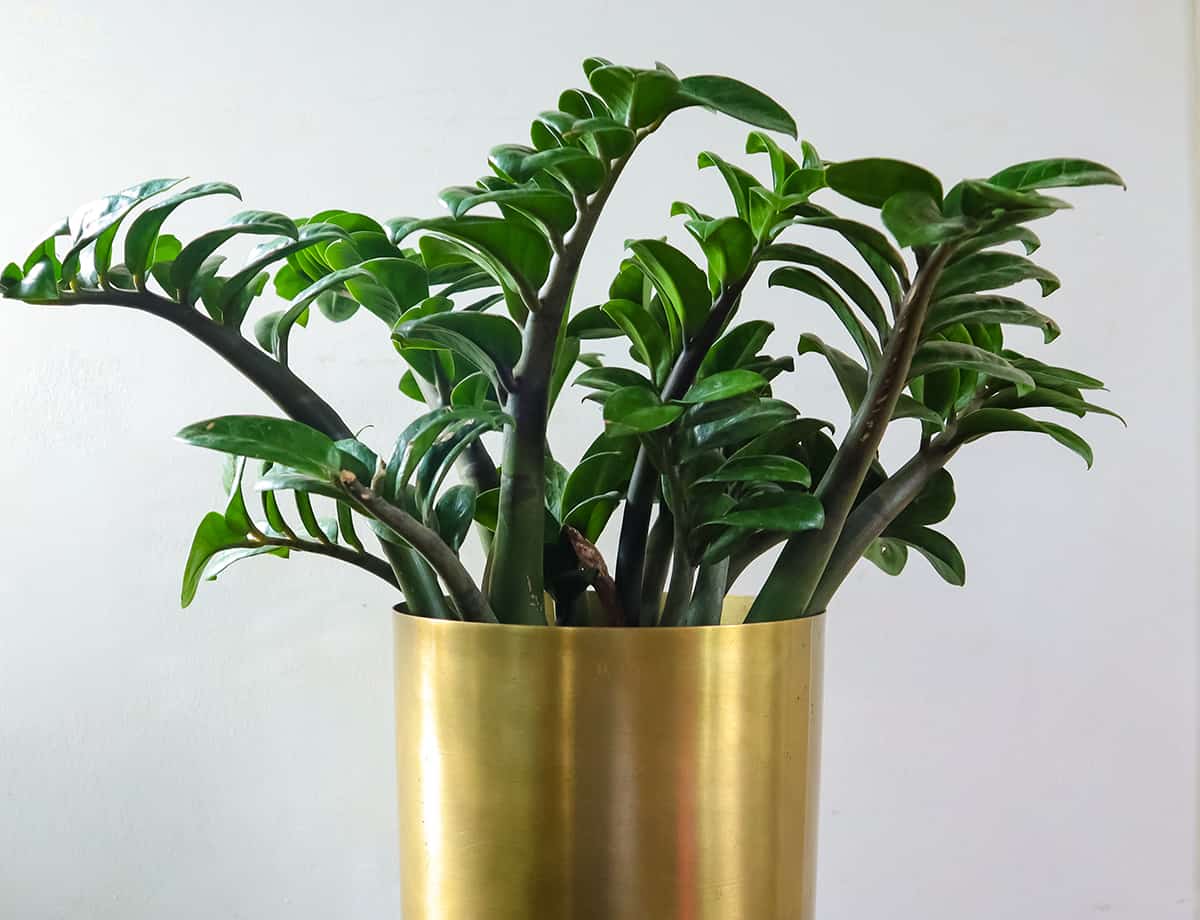
- Botanical name: Zamioculcas zamiifolia
- Common names: ZZ Plant, Zuzu Plant, Zanzibar Gem, Emerald Palm
- Plant family: Araceae
- USDA hardiness zone: 10 – 12
- Mature height: 4 feet
- Mature spread: 2 feet
The ZZ Plant is a slow-growing evergreen that grows from rhizomes beneath the soil. It hails from eastern Africa and South Africa and is also a much-loved houseplant in cooler regions. The popularity of this plant is largely due to the fact that it is so easy to grow, in fact, many consider it to be almost impossible to kill. It thrives on neglect and needs little water and little light. It produces firm, gently arching stems of ovate, thick emerald leaves with a glossy surface.
To produce a new ZZ Plant, all you need is a healthy leaf cutting from an existing plant. Remove the leaf from the stem using a clean pair of scissors, and then plant the cutting with the exposed part of the leaf down in a dish of soil mix.
The soil should be kept moist but not wet to encourage the leaf to send out roots. As a very slow-growing plant, the ZZ Plant can take a long time to root, so patience will be necessary. Once roots appear, you can move the baby plant to a larger pot and continue care as normal.
Kalanchoe
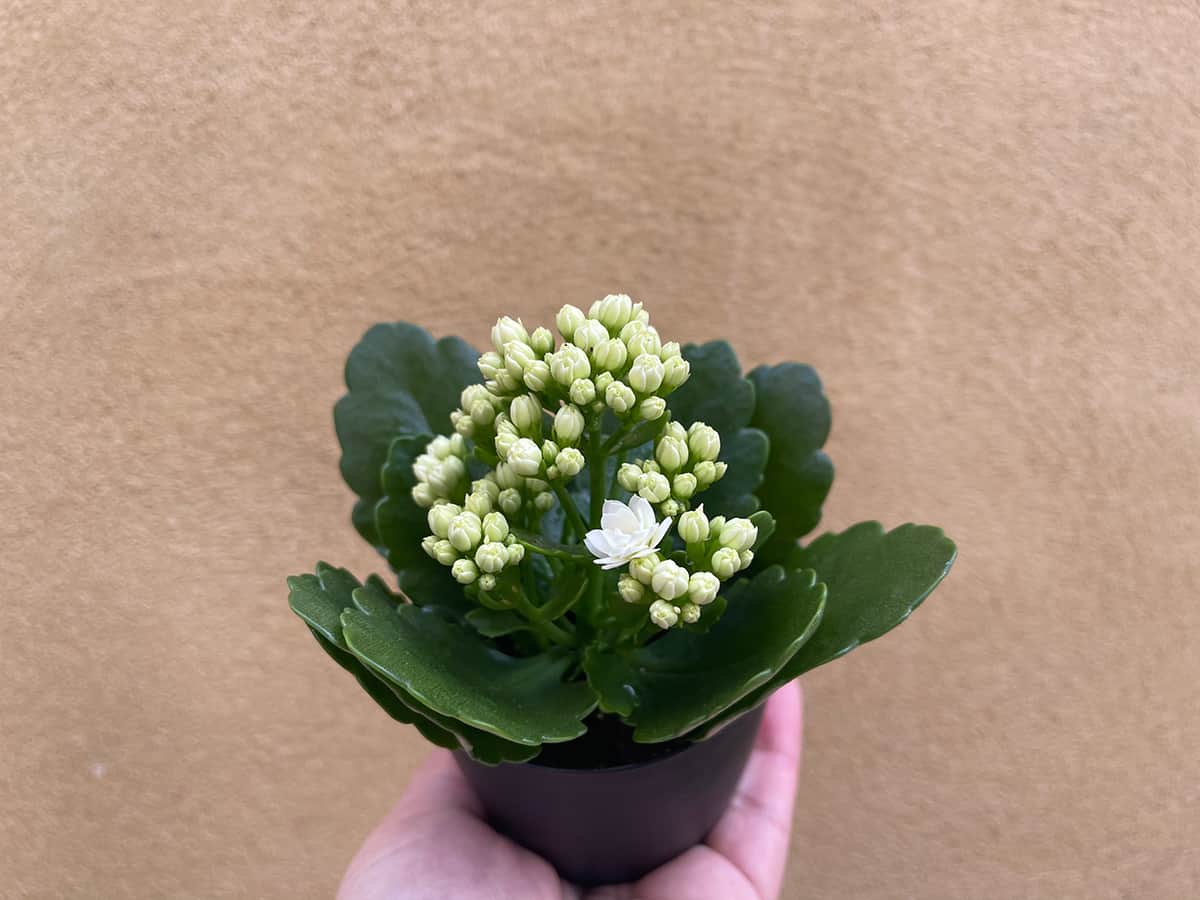
- Botanical name: Kalanchoe blossfeldiana
- Common names: Kalanchoe, Florist’s Kalanchoe, Flaming Katy, Christmas Kalanchoe
- Plant family: Crassulaceae
- USDA hardiness zone: 10 – 12
- Mature height: 1 foot
- Mature spread: 1 foot
There are over 100 different types of Kalanchoe, but the most commonly cultivated genus is the Kalanchoe blossfeldiana. This originates from Madagascar but is also widely grown outdoors in hot climates and as a flowering houseplant in cooler regions. The Kalanchoe is considered to be a succulent or semi-succulent since it has fleshy leaves that store moisture, though they are not very thick. This plant thrives in sunny, warm conditions and can survive drought.
To propagate a Kalanchoe through leaf cuttings, remove a healthy leaf from the stem of an existing plant using clean scissors. Next, put the leaf in a brown paper bag or some dry folded kitchen towel, and leave it for a few days. This will allow the cut part of the leaf to callous over, avoiding rot when the leaf is subjected to moisture in the next step.
Once calloused over, lay your leaf on top of some gritty, well-draining soil mix, or a cacti soil mix. Spray the soil with a water mister every few days to keep it very lightly moist; this will encourage root growth and minimize the chance of rot. Roots should appear within two weeks. Let the roots grow stronger for up to six weeks, and then plant the cuttings and their root systems in a new pot.
Jade Plant
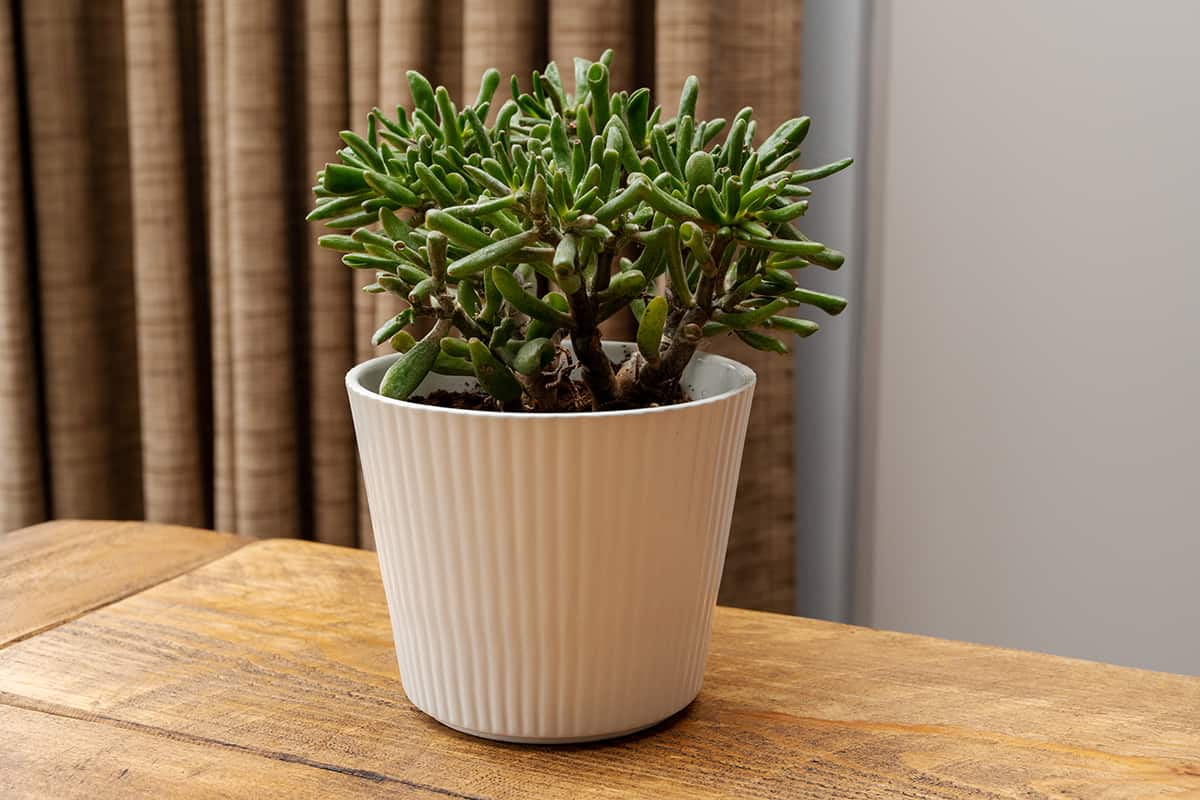
- Botanical name: Crassula ovata
- Common names: Jade Plant, Money Plant, Lucky Plant, Money Tree
- Plant family: Crassulaceae
- USDA hardiness zone: 10 – 12
- Mature height: 10 feet
- Mature spread: 6 feet
The Jade Plant is native to South Africa, where it can reach heights of up to 10 feet in its natural habitat, though rarely exceeds 6 feet when grown indoors. It is a multi-branching succulent that takes the shape of a tree as it ages. The rounded leaves of the Jade Plant are thick, smooth, and fleshy. They hold moisture which allows the plant to survive long periods of drought. These plants grow best in bright light, but they can also tolerate some shade.
To produce a new Jade Plant from an existing plant, gently tug the leaves away from the stem until they break off. The leaves will need to be callous over to help prevent rot, so leave them in a dark and dry spot for a few days to allow this to happen. Once calloused over, the leaves can be placed on top of some damp potting soil, with the calloused ends slightly tucked in. Set these in a bright and warm spot for two weeks, and avoid watering.
Once roots have formed, you can add a little water to the soil and then wait a further two weeks for the soil to dry out before watering again. Once the roots are well established, pot up your mini Jade Plants in small individual pots.
Echeveria
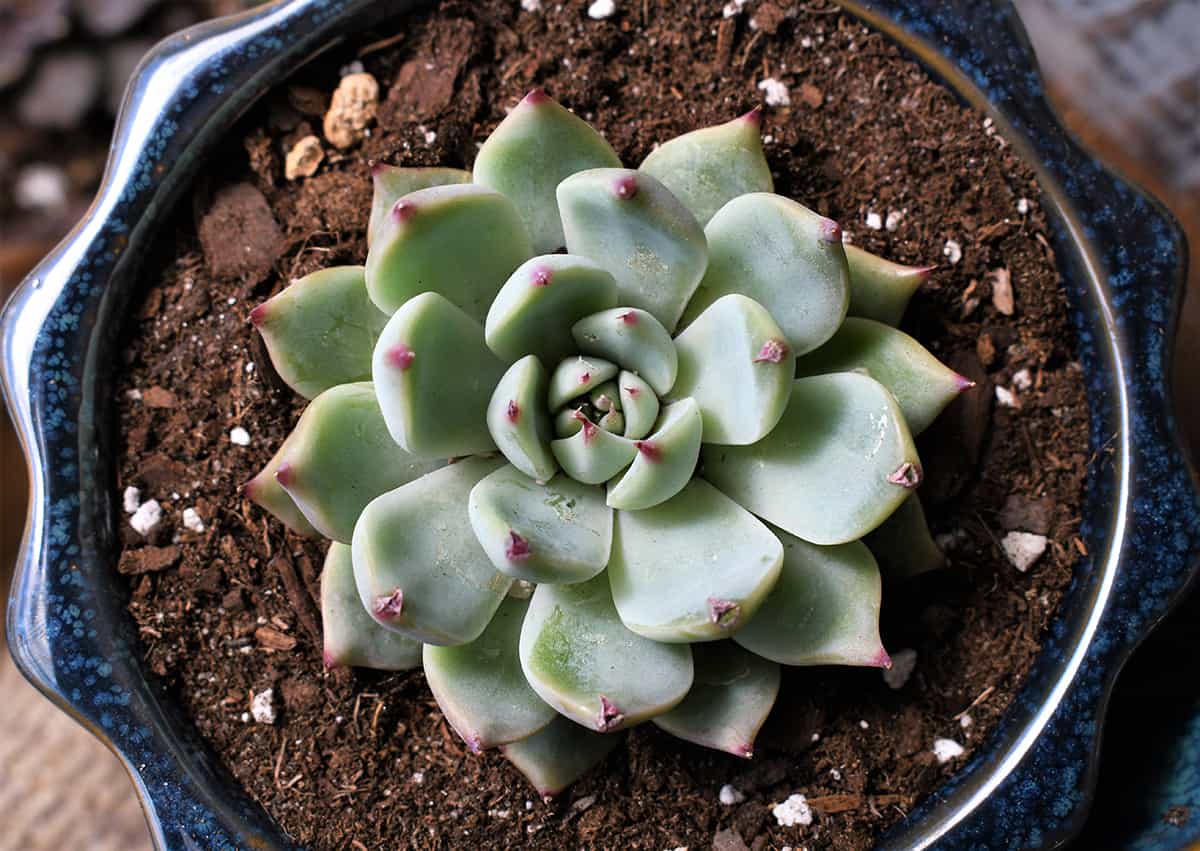
- Botanical name: Echeveria sp.
- Common names: Echeveria, Hens and Chicks,
- Plant family: Crassulaceae
- USDA hardiness zone: 9 – 11
- Mature height: 2 to 24 inches
- Mature spread: 2 to 12 inches
Echeveria is a genus of succulents that take the form of rosette-shaped plants. They typically have thick, fleshy leaves, and are relatively low-growing. There are many different varieties of Echeveria, whose leaves range in color from white-gray to lime green and orange. Echeveria plants grow easily, and they readily propagate themselves by sending out new plants in the form of pups or ‘chicks’. However, you can also propagate Echeveria through leaf cuttings.
To propagate Echeveria via leaf cutting, use a sharp knife or scissors to slice off one of the lower leaves, or gently tug it away from the stem. Avoid cutting away the uppermost leaves as this will ruin the look of your rosettes. Place the cut leaves on a piece of dry paper and set them in a cool spot for several weeks.
Roots will begin to form from the cut part of the leaf, and tiny new leaves will emerge. When the root system is developed enough, place the new plant in a pot of damp, well-draining soil. The original leaf cutting can be removed or it can be left to die back naturally, as it won’t form part of the new plant. Instead, the tiny new leaves which grow from the end of the cutting will become the new rosette.
Burro’s Tail (Sedum Morganianum)
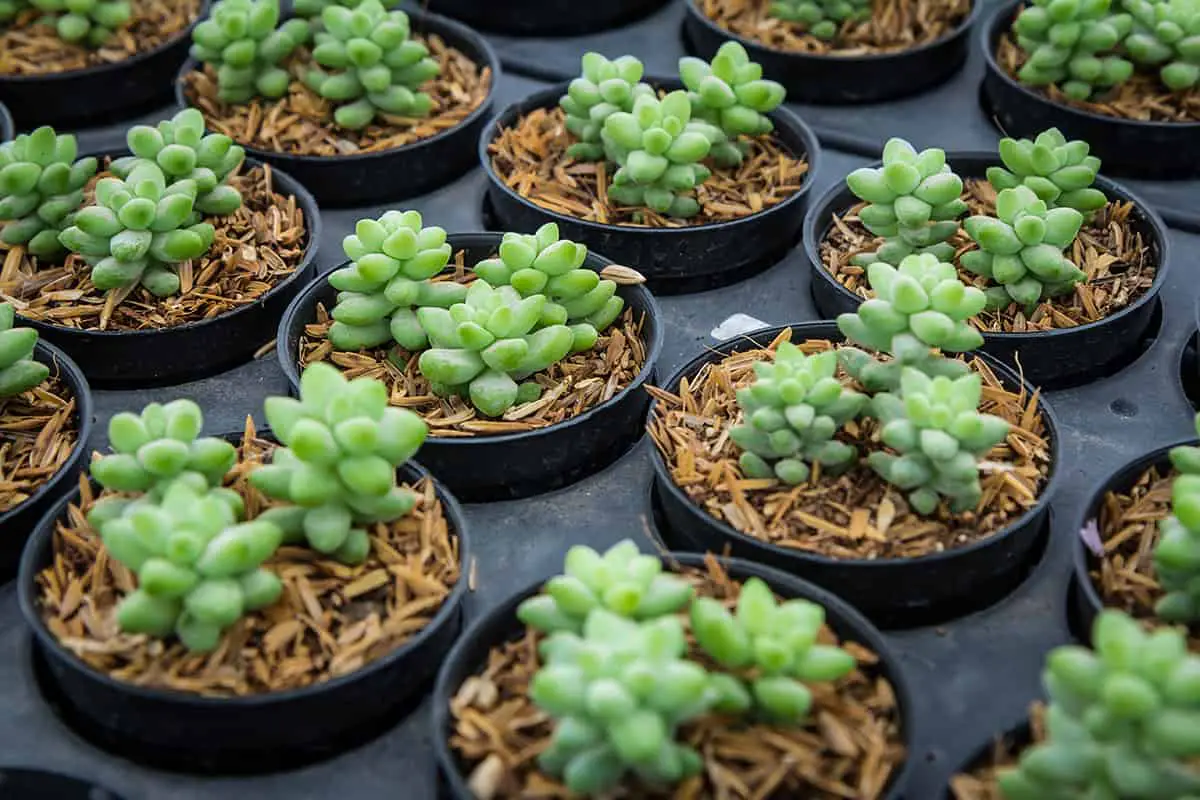
- Botanical Name: Sedum morganianum
- Common Name: Burro’s Tail
- Plant Family: Crassulaceae
- USDA Hardiness Zone: 10-11
- Mature Height: Up to 4 inches (10 cm) in height
- Mature Spread: Can trail over 3 feet (90 cm) in length
Sedum Morganianum, commonly known as Burro’s Tail, is a succulent that thrives indoors. Your Burro’s Tail will exhibit fleshy, blue-green leaves. These grow along long, trailing stems, creating a visually striking display.
Burro’s Tail prefers bright light. Ensure you place it in a well-lit area, but not in direct sunlight. Keep your plants in a room where the temperature is consistently above 40 degrees Fahrenheit, especially when moved outside.
With its stems potentially growing up to 24 inches, the Burro’s Tail is perfect for hanging baskets. This plant has delicate leaves that can fall off easily. Handle it with care. Minimal watering is required, as with most succulents, making maintenance straightforward.
You can grow new Burro’s Tail plants from individual leaves. When a leaf falls, it has the potential to take root and form a new plant. Give it time to callous over before placing it on well-draining soil.
Peperomia Spp.
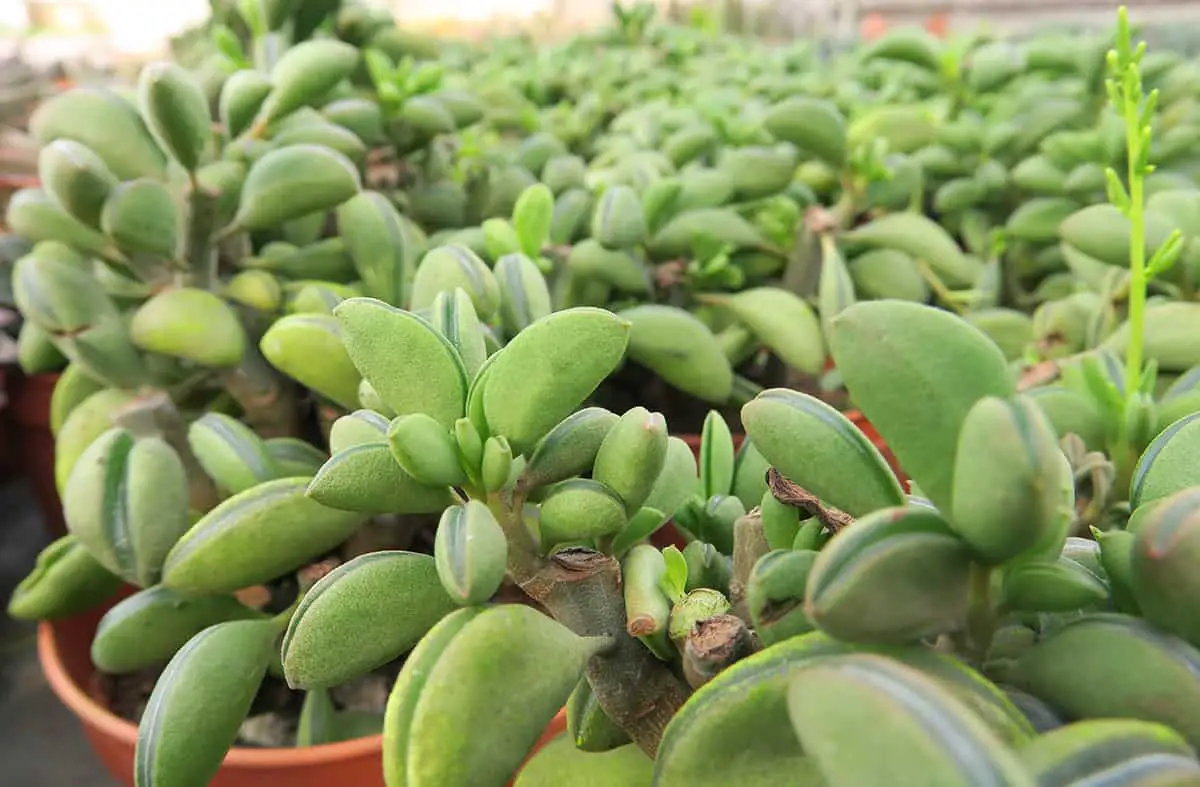
- Botanical Name: Peperomia spp.
- Common Name: Radiator Plant
- Plant Family: Piperaceae
- USDA Hardiness Zone: 10-12 (mostly grown as indoor plants elsewhere)
- Mature Height: Typically 6-12 inches (15-30 cm) in height
- Mature Spread: Usually around 8-12 inches (20-30 cm) wide
These houseplants belong to a large tropical genus. They suit a variety of indoor conditions.
The leaves of Peperomia are unique and varied. They can be smooth or textured. The foliage often shows off intricate patterns. Some leaves resemble watermelon rinds, as seen in Peperomia argyreia.
To propagate your Peperomia, choose healthy leaves. Cut them carefully with a sterilized tool. Let the cut surface dry briefly. Then, plant the leaf in a well-drained potting mix. It’s essential to maintain a balance in watering. Avoid overwatering, as this could cause root rot.
Your Peperomia will thrive in indirect light. They prefer environments that mimic their natural habitat. Moderate temperatures and humidity are ideal. The genus boasts over 1000 species, offering variety.
While similar to the pepper plant, Peperomia are solely ornamental. They’re not related to the peppers you eat. Yet, they share a family with the black pepper plant. Keep them as decorative houseplants only, as their diversity enhances home spaces.
Begonia
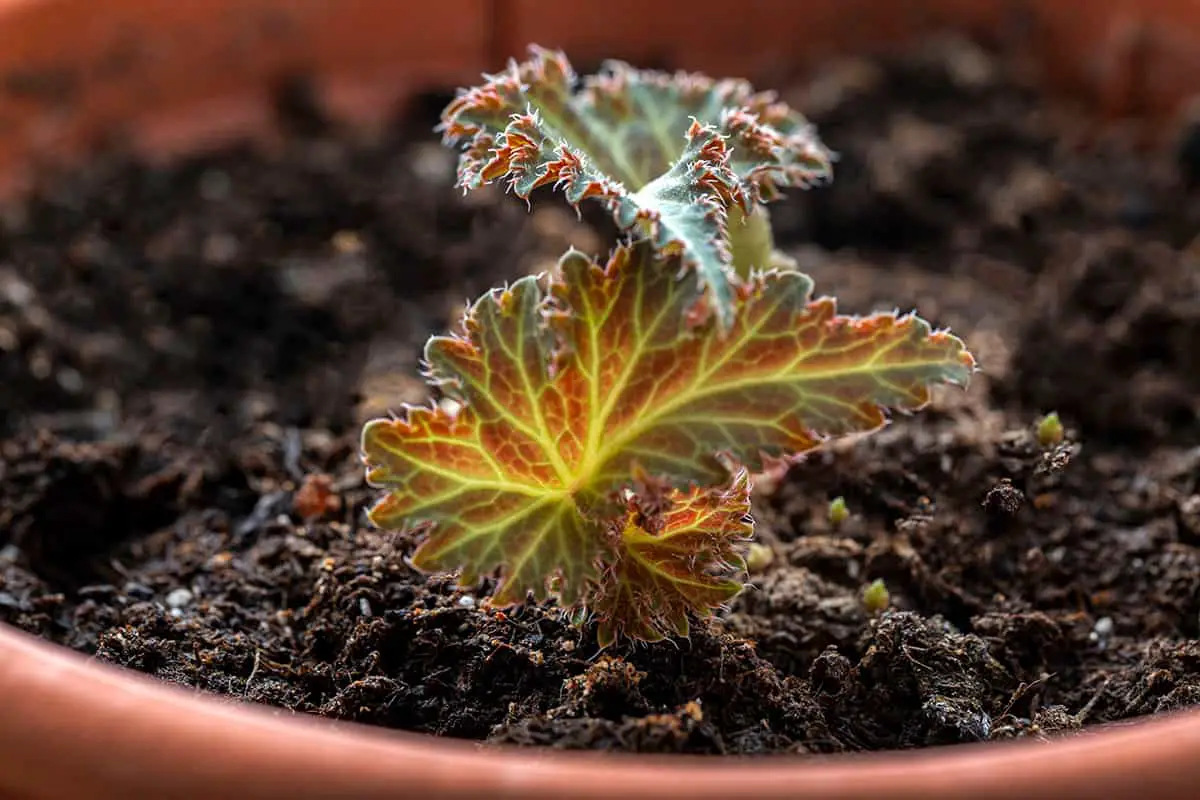
- Botanical Name: Begonia spp.
- Common Name: Begonia
- Plant Family: Begoniaceae
- USDA Hardiness Zone: 6-11 (varies by species; often grown as annuals or indoors)
- Mature Height: Ranges from 6 inches to 3 feet (15 cm to 91 cm)
- Mature Spread: Typically 6 inches to 2 feet (15 cm to 61 cm)
Begonias are a diverse group of houseplants known for their beautiful leaves. They grow well indoors and can propagate from their leaves. To start a new plant, you cut a healthy begonia leaf. Then, you place the leaf on moist soil. In time, new growth emerges from the base of the leaf.
Some begonias, like the Rex begonia, are specifically prized for their colorful foliage. Others, such as tuberous begonias, dazzle with their flowers. You find these plants in shades of green, red, silver, and more. They offer a unique look to your home.
Your care keeps these plants thriving. They prefer bright, indirect light and well-draining soil. Water them when the topsoil feels dry. Remember, overwatering can harm them.
African Violet (Saintpaulia)
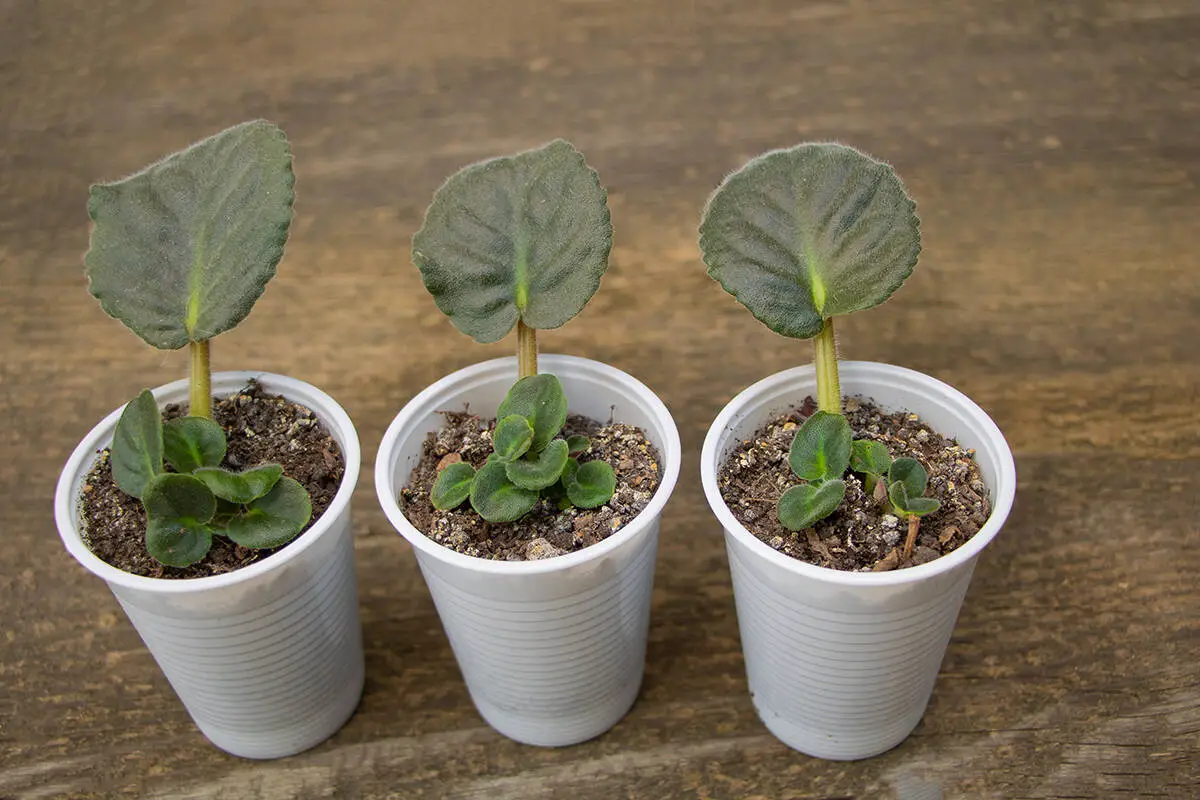
- Botanical Name: Saintpaulia spp.
- Common Name: African Violet
- Plant Family: Gesneriaceae
- USDA Hardiness Zone: Typically grown as an indoor plant
- Mature Height: About 6 inches (15 cm)
- Mature Spread: 6 to 12 inches (15 to 30 cm)
You can easily propagate African Violet using leaf cuttings. Start by selecting a healthy leaf and cutting it with a sharp knife. Plant the stem in a mix of peat moss and perlite for best results.
The plant will thrive in moderate conditions. It prefers well-drained soil and indirect sunlight. Make sure to keep the soil moist but not waterlogged. Room temperatures between 65 to 75°F (18 to 24°C) create an ideal environment for growth.
With proper care, your African Violet will bloom multiple times a year. Flowers range from blue, purple, to white. Regularly remove dead foliage and spent blooms to encourage new flowers. This will keep your plant looking fresh.
Maintain the right humidity around your African Violet. Grouping houseplants or using a humidity tray can help. Rotate the pot weekly for even growth. This ensures all sides receive equal light and promotes a symmetrical shape.
Chinese Money Plant (Pilea Peperomioides)
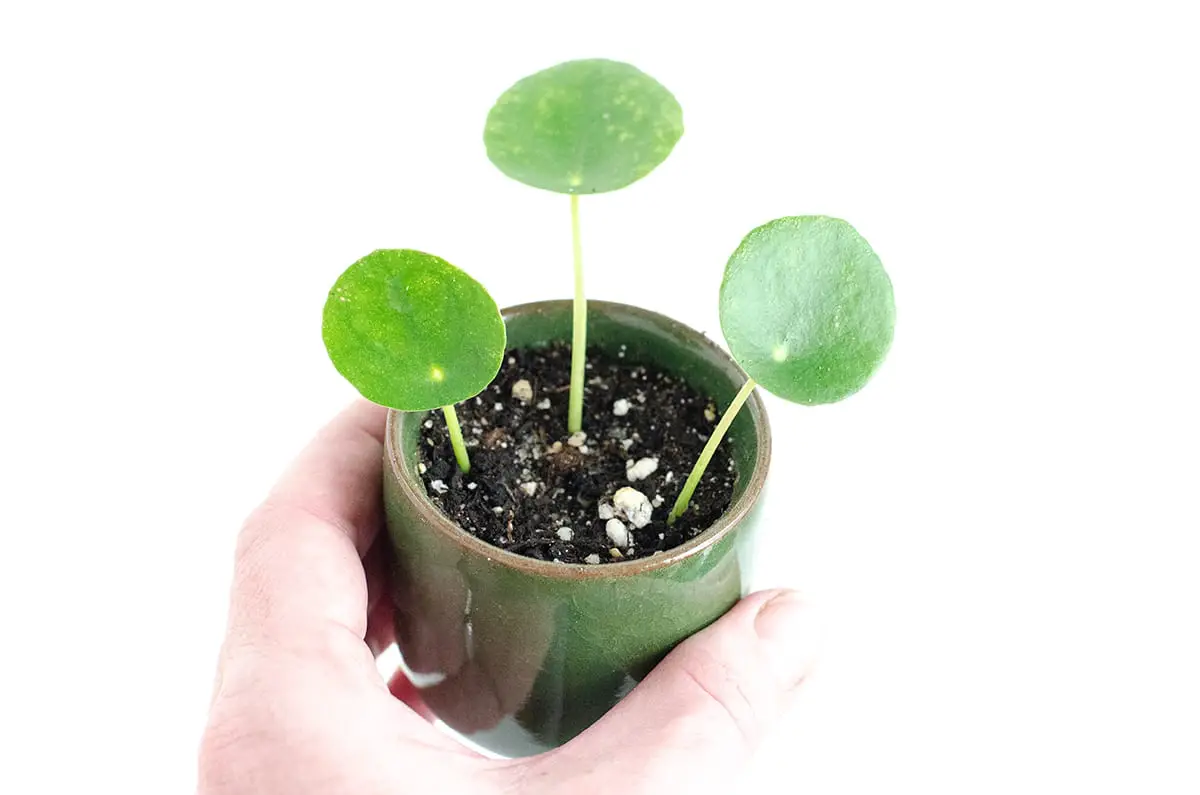
- Botanical Name: Pilea peperomioides
- Common Name: Chinese Money Plant
- Plant Family: Urticaceae
- USDA Hardiness Zone: 10-12 (commonly grown indoors)
- Mature Height: 8 to 12 inches (20 to 30 cm)
- Mature Spread: 8 to 12 inches (20 to 30 cm)
The Pilea Peperomioides, also known as the Chinese Money Plant, presents an attractive look for your home. With its round, shiny leaves, you’ll find they seem to float above the pot. These coin-shaped leaves make the plant a popular choice.
Your Chinese Money Plant thrives in bright, indirect light. Be mindful of too much direct sunlight as it can scorch the leaves. Provide moderate watering, letting the soil dry out between sessions.
When you want to propagate, know this plant makes it simple. Cut a healthy leaf with a small stem attached and place it in water. Roots will develop, and you can then plant it in soil.
Caring for your Chinese Money Plant requires minimal effort. This easygoing nature makes it a favored houseplant for both beginners and experienced gardeners.
Hoya
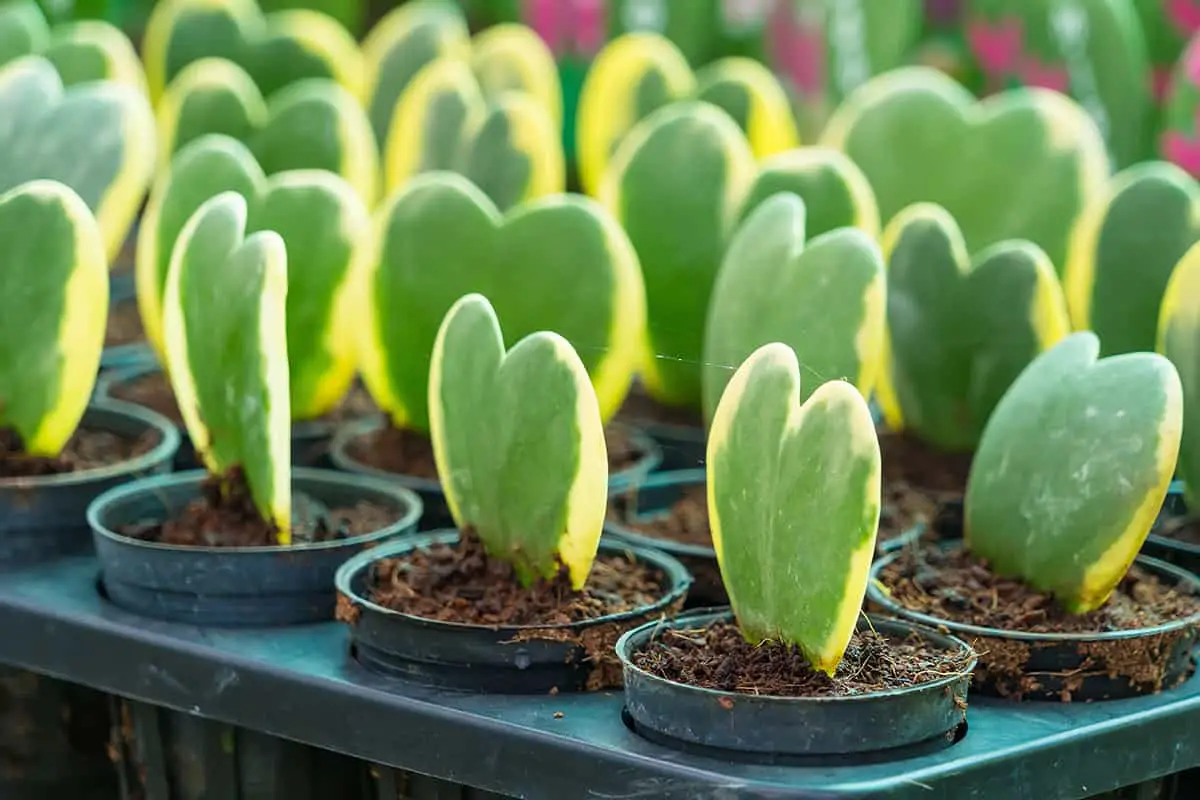
- Botanical Name: Hoya spp.
- Common Name: Wax Plant
- Plant Family: Apocynaceae
- USDA Hardiness Zone: 9-11 (commonly grown indoors in cooler climates)
- Mature Height: Varies widely, some species can climb or trail over 10 feet
- Mature Spread: Spread can vary; some species form dense clusters while others trail
Hoyas are attractive houseplants you can grow from leaves. They are commonly known as wax plants. Hoyas have waxy leaves and star-shaped flowers. You can find them in various leaf shapes and colors.
To propagate a hoya, select a healthy leaf. Plant the leaf in well-draining soil. Keep the soil moist but not overly wet. Ensure your hoya gets bright, indirect light.
Once rooted, hoya plants require little maintenance. They thrive in a warm environment. Hoyas prefer to be slightly root-bound. This encourages them to bloom.
Your hoya will produce sweet-smelling flowers. The flowers of hoya are often pink or white. You can enhance flowering by providing enough light and not overwatering.
Strawberry Begonia (Saxifraga Stolonifera)
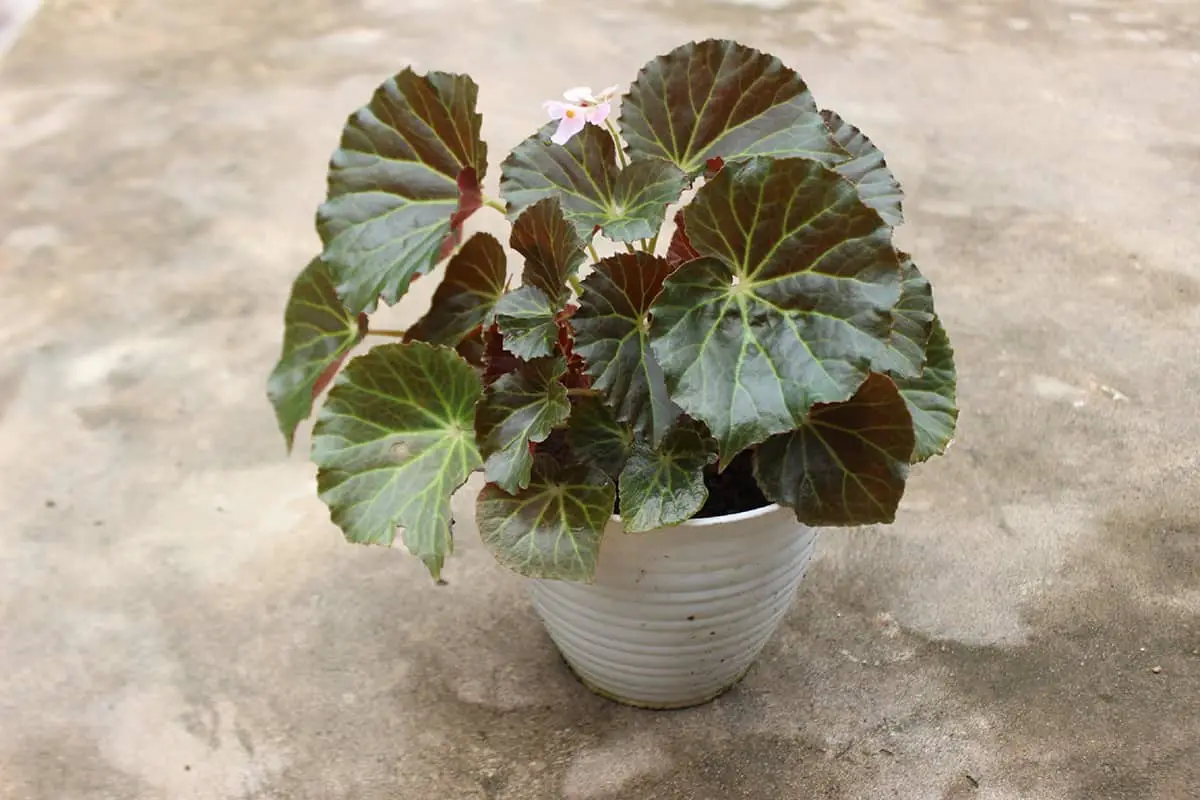
- Botanical Name: Saxifraga stolonifera
- Common Name: Strawberry Begonia, Creeping Saxifrage
- Plant Family: Saxifragaceae
- USDA Hardiness Zone: 6-9
- Mature Height: 6 to 8 inches (15 to 20 cm)
- Mature Spread: 12 to 18 inches (30 to 45 cm)
Strawberry Begonia, or Saxifraga Stolonifera, is a charming houseplant. It earns its name from the strawberry-like runners it sends out. These runners, or stolons, produce new plantlets. You can easily propagate them to expand your collection.
Strawberry Begonia thrives in indirect light. Ensure your plant’s soil stays moist but not soggy. It’s a balance that keeps the plant healthy. The leaves are rounded with silver markings, and a fine hair covers them. This texture adds a pleasant touch to your indoor greenscape.
In the right conditions, Saxifraga Stolonifera blooms. Expect small, white flowers in spring or summer. They add an understated elegance to the plant’s foliage. This plant not only beautifies your space but needs minimal care.
Remember, despite its name, it’s not a true begonia. Your Strawberry Begonia enjoys cooler environments. It’s happiest away from harsh, direct sunlight. With proper care, this plant forms a spreading mat, ideal for hanging baskets or elevated planters. It provides a cascade of green and silver that can brighten any corner of your home.
Cape Primrose (Streptocarpus)
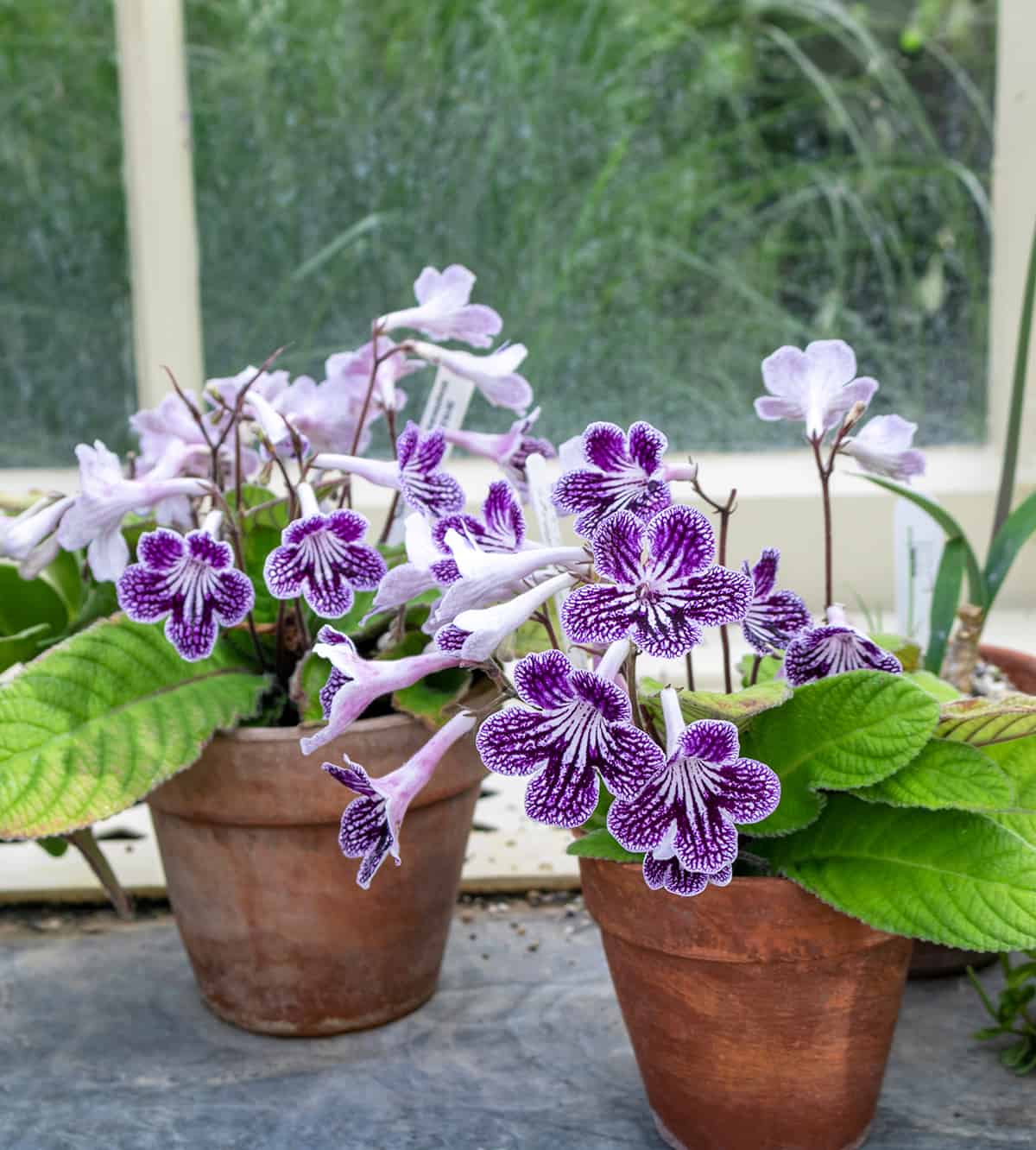
- Botanical Name: Streptocarpus spp.
- Common Name: Cape Primrose
- Plant Family: Gesneriaceae
- USDA Hardiness Zone: Typically grown as a houseplant; outdoor zones 10-11
- Mature Height: 6 to 12 inches (15 to 30 cm)
- Mature Spread: 12 to 24 inches (30 to 60 cm)
Cape Primrose, also known as Streptocarpus, is a popular houseplant. You can grow this plant successfully if you’re familiar with African violets. Its leaves efficiently produce new plants.
The leaves of Cape Primrose are long and narrow. They often feature wavy edges. From them, new plants can sprout through leaf cuttings. This propagation method involves the leaf blade and the petiole.
Cape Primrose thrives in moderate, indirect light. You’ll notice it blooms sporadically throughout the year. Its flowers come in shades of white, blue, pink, and more. Contrastingly colored blotches may adorn them.
For healthy growth, keep your Streptocarpus in well-draining soil. Ensure you maintain consistent moisture without overwatering.
Ghost Plant (Graptopetalum Paraguayense)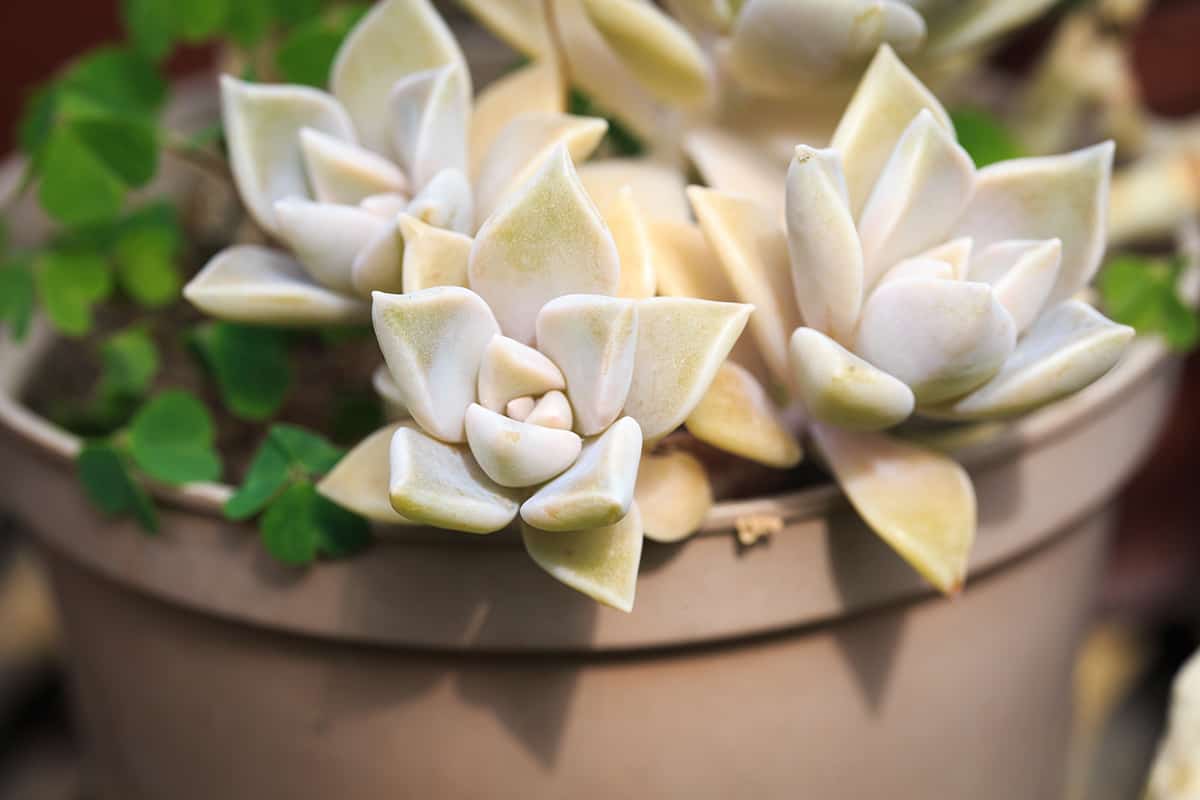
- Botanical Name: Graptopetalum paraguayense
- Common Name: Ghost Plant
- Plant Family: Crassulaceae
- USDA Hardiness Zone: 9-11
- Mature Height: 6 to 12 inches (15 to 30 cm)
- Mature Spread: 12 to 24 inches (30 to 60 cm)
Ghost Plant, or Graptopetalum Paraguayense, is a fascinating houseplant you can easily grow from leaves. It’s native to Mexico and thrives in a variety of conditions. This succulent has fleshy leaves that form a rosette shape, making it an attractive addition to your indoor plant collection.
The leaves are a unique feature; they possess a pearly, whitish color that can blush pink in dry heat or take on a blue hue in partial shade. Ghost Plants need a moderate source of light but should avoid long periods of direct summer sun. Morning sun is ideal to maintain their color and health.
To propagate, simply choose a healthy leaf and gently twist it from the stem. Make sure you get the entire leaf without leaving any part on the stem. Let it dry for a day or two until the cut end callouses over. Place the leaf cut-side down on moist soil. In time, roots and new shoots will emerge.
The Ghost Plant’s versatility is impressive. It can serve as ground cover, cascade down from a container, or live happily as a thriving houseplant. Given the right conditions, it will grow up to one foot tall and spread 2-3 feet wide.
Gollum Jade (Crassula Ovata ‘Gollum’)
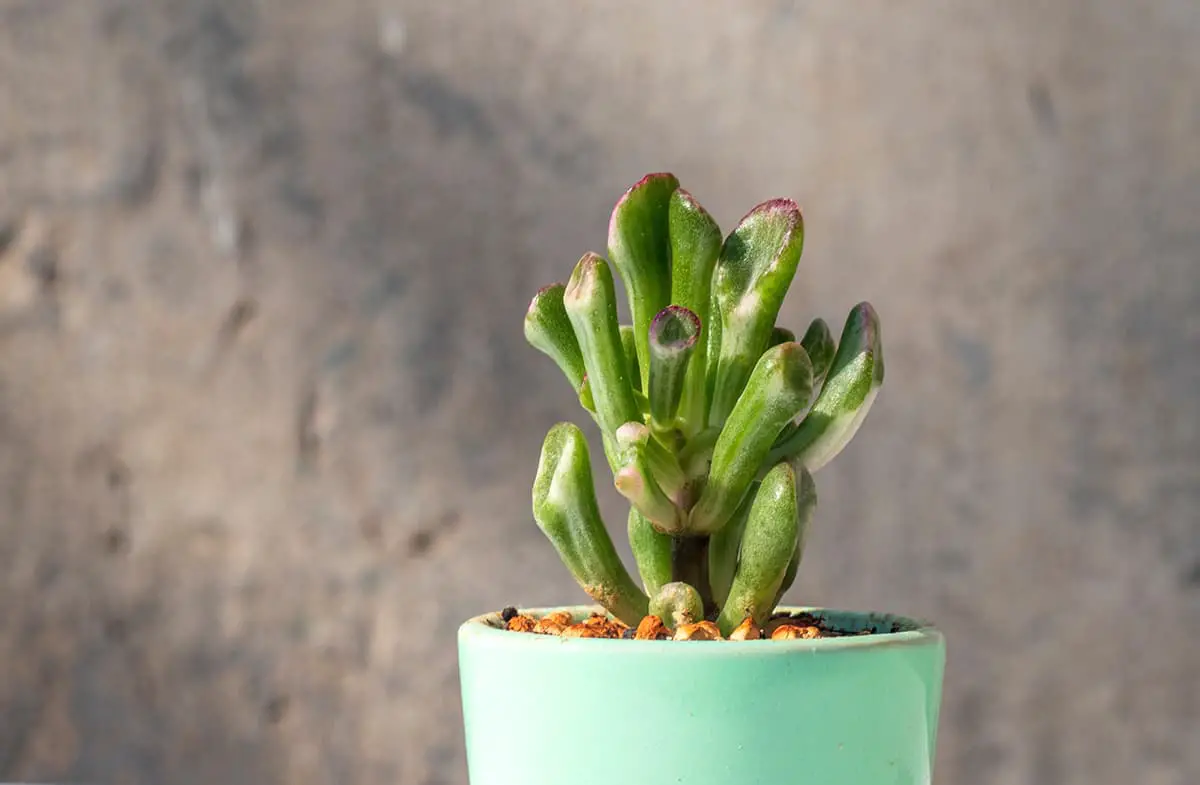
- Botanical Name: Crassula ovata ‘Gollum’
- Common Name: Gollum Jade
- Plant Family: Crassulaceae
- USDA Hardiness Zone: 9-12
- Mature Height: Up to 3 feet (90 cm)
- Mature Spread: Up to 2 feet (60 cm)
The Gollum Jade is a succulent plant that thrives indoors. It’s a cultivar of Crassula ovata, beloved for its unique, tube-shaped leaves. The leaves often present a lush green color with red-tinted tips. This plant adapts well to indoor environments, making it suitable for your home.
To propagate Gollum Jade, choose a healthy leaf. Let it dry for a day or two to prevent rotting. Place it on well-draining soil. Water sparingly until roots develop.
Light and water needs are simple. Place your Gollum Jade in bright, indirect sunlight. Overwatering can harm your plant, so let the soil dry between waterings. This careful balance ensures your jade plant’s growth.






